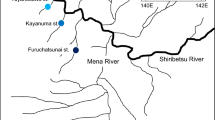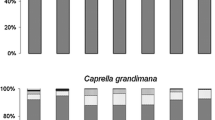Abstract
Fatty acid analysis is an alternative dietary investigation tool that complements the more traditional techniques of stomach content and faecal analysis that are often subject to a wide range of biases. In applying fatty acid analysis to ecosystem studies, it is important to have an understanding of the effect diet has on the fatty acid profile of the predator. A feeding experiment, using crustacean and fish as prey for the European cuttlefish Sepia officinalis, was conducted to evaluate the effect of prey fatty acids on the fatty acid profile of this marine predator. Cuttlefish were fed on a fish diet for the first 29 days, and then changed to a crustacean diet for a further 28 days. Another group of cuttlefish was fed on a crustacean diet for the first 29 days, and then changed to a fish diet for a further 28 days. An analysis of the cuttlefish digestive gland showed that the fatty acid profile reflected that of the prey, with cuttlefish on a crustacean diet being clearly distinguishable from the cuttlefish on a fish diet. Cuttlefish fed on a fish diet for 29 days prior to the switch in diet were comparatively higher in 16:0, AA, 20:1ω9, DPA6, DHA, 22:4ω6 and DPA3 than those fed on crustaceans. Cuttlefish fed on a crustacean diet for 29 days prior to the switch in diet were comparatively higher in 17:1ω8, 18:1ω9, 18:2ω6, 18:1ω7, EPA and 20:2ω6 than those fed on fish. Following a change in diet, the fatty acid profile of the cuttlefish digestive gland reflected that of the new diet within 14 days. The results confirm that the fatty acid profile of the cuttlefish digestive gland clearly reflects the profile of its recent diet. It also shows that the digestive gland may not be an organ that accumulates dietary lipids for long-term storage, but rather is an organ where lipids are rapidly being turned over and potentially excreted.


Similar content being viewed by others
References
Ackman RG (1980) Fish lipids. Part 1. In: Connell JJ (ed) Advances in fish science and technology : papers presented at the Jubilee conference of the Torry Research Station, Aberdeen, Scotland, 23–27 July 1979. Fishing News Books, Farnham, England, pp 86–103
Alonzo F, Virtue P, Nicol S, Nichols PD (2005) Lipids as trophic markers in Antarctic krill. II. Lipid composition of the body and digestive gland of Euphausia superba in controlled conditions. Mar Ecol Prog Ser 296:65–79
Bligh EG, Dyer WJ (1959) A rapid method of total lipid extraction and purification. Can J Biochem Phys 37(8):911–917
Boletzky SV (1983) Sepia officinalis. In: Boyle PR (ed) Cephalopod life cycles, vol 1. Academic Press, London, pp 31–52
Boucher-Rodoni R, Boucaud-Camou E, Mangold K (1987) Feeding and digestion. In: Boyle PR (eds) Cephalopod life cycles, Vol 2. Academic Press, London, pp 85–108
Boyle PR, Rodhouse P (2005) Cephalopods: ecology and fisheries. Blackwell Science, Oxford
Castro BG, Garrido JL, Sotelo CG (1992) Changes in composition of digestive gland and mantle muscle of the cuttlefish Sepia Officinalis during starvation. Mar Biol 114:11–20
Clarke MR (1996) The role of cephalopods in the world’s oceans: general conclusions and the future. Phil Trans Roy Soc Lond B 351:1105–1112
Cowey CB, Sargent JR (1972) Fish nutrition. Adv Mar Biol 10:383–492
Dunn MR (1999) Aspects of the stock dynamics and exploitation of cuttlefish, Sepia officinalis (Linnaeus, 1758), in the English Channel. Fish Res 40:277–293
FAO species catalogue for fishery purposes (2005) In: Jereb P, Roper CFE (eds) Cephalopods of the world. I. Species known to date. No. 4. vol.1. Food & Agriculture Organization of the United Nations, Rome
Gales NJ, Cheal AJ (1992) Estimating diet composition of the Australian sea-lion (Neophoca cinerea) from Scat analysis: an unreliable technique. Wildlife Res 19:447–456
Guerra A (2006) Ecology of Sepia officinalis. Vie Milieu 56(2):97–107
Hirtle RW, Demont ME, O’Dor RK (1981) Feeding, growth and metabolic rates in captive squid, Illex illecebrosus. J Shellfish Res 1:187–192
Iverson SJ, Field C, Bowen WD, Blanchard W (2004) Quantitative fatty acid signature analysis: a new method of estimating predator diets. Ecole Monog 74(2):211–235
Jackson GD, O’Dor RK (2001) Time, space and the ecophysiology of squid growth, life in the fast lane. Vie Milieu 51:205–215
Jackson GD, Bustamante P, Cherel Y, Fulton EA, Grist EPM, Jackson CH, Nichols PD, Pethybridge H, Phillips K, Ward RD, Xavier JC (2007) Applying new tools to cephalopod trophic dynamics and ecology: perspectives from the Southern Ocean Cephalopod Workshop, February 2–3, 2006. Rev Fish Biol Fisheries 17:79–99
Moltschanlwskyj N, Johnston D (2006) Evidence the lipid can be digested by the dumpling squid Euprymna tasmanica, but is not stored in the digestive gland. Mar Biol 149:565–572
Navarro JC, Villanueva R (2003) The fatty acid composition of Octopus vulgaris paralarvae reared with live and inert food: deviation from their natural fatty acid profile. Aquaculture 219:613–631
O’Dor RK, Webber DM (1986) The constraints on cephalopods: why squid aren’t fish. Can J Zool 64:1591–1605
O’Dor RK (1992) Big squid in big currents. S Afr J Mar Sci 12:225–235
Parrish CC, Abrajano TA, Budge SM, Helleur RJ, Hudson ED, Pulchan K, Ramos C (2000) Lipid and phenolic biomarkers in marine ecosystems: analysis and applications. In: Wangersky P (ed) The handbook of environmental chemistry, vol 5: Part D. Springer, Berlin
Pethybridge H (2004) Diet of squid (T. fillipovae): lipid and stomach analysis. B.Sc (Honours) Thesis, University of Tasmania pp79
Phillips KL, Jackson GD, Nichols PD (2001) Predation on myctophids by the squid Moroteuthis ingens around Macquarie and Heard Islands: stomach contents and fatty acid analyses. Mar Ecol Prog Ser 215:179–189
Phillips KL, Nichols PD, Jackson GD (2002) Lipid and fatty acid composition of the mantle and digestive gland of four Southern ocean squid species: implications for food-web studies. Antarctic Sci 14(3):212–220
Phillips KL, Nichols PD, Jackson GD (2003) Dietary variation of the squid Moroteuthis ingens at four sites in the Southern ocean: stomach contents, lipid and fatty acid profiles. J Mar Biol Ass UK 83:523–534
Phleger CF, Nichols PD, Virtue P (1998) Lipids and trophodynamics of Antarctic zooplankton. Comp Biochem Physiol B 120:311–323
Santos MB, Clarke MR, Pierce GJ (2001) Assessing the importance of cephalopods in the diets of marine mammals and other top predators: problems and solutions. Fish Res 52:121–139
Sauer WHH, Smale MJ, Lipinski MR (1992) The location of spawning grounds, spawning and schooling behaviour of the squid Loligo vulgaris reynaudii (Cephalopoda, Myopsida) off the eastern cape coast, South Africa. Mar Biol 114(1):97–107
Semmens JM (1998) An examination of the role of the digestive gland of two loliginig squids, wtih respect to lipid: storage or excretion? Proc Roy Soc Lond B 265:1685–1690
Stowasser G, Pierce GJ, Moffat CF, Collins MA, Forsythe JW (2006) Experimental study on the effect of diet on fatty acid and stable isotope profiles of the squid Lolliguncula brevis. J Exp Mar Biol Ecol 333:97–114
Wang JJ, Pierce GJ, Boyle PR, Denis V, Robin JP, Bellido JM (2003) Spatial and temporal patterns of cuttlefish (Sepia officinalis) abundance and environmental influences—a case study using trawl fishery data in French Atlantic coastal, English Channel, and adjacent waters. ICES J Mar Sci 60:1149–1158
Westermann B, Beuerlein K, Ruth P, Schipp R (2000) Tracer studies of food absorption in the digestive tract of Nautilus pompilius (Cephalopoda, Tetrabranchiata). Cell Tissue Res 300:173–179
Acknowledgments
This work was made possible by the funding from the Hermon Slade foundation with a grant awarded to G.D. Jackson. We are thankful for the National Resource Centre for Cephalopods who provided the excellent facilities for conducting this research.
Author information
Authors and Affiliations
Corresponding author
Additional information
Communicated by H.O. Pörtner.
Rights and permissions
About this article
Cite this article
Fluckiger, M., Jackson, G.D., Nichols, P. et al. An experimental study of the effect of diet on the fatty acid profiles of the European Cuttlefish (Sepia officinalis). Mar Biol 154, 363–372 (2008). https://doi.org/10.1007/s00227-008-0932-0
Received:
Accepted:
Published:
Issue Date:
DOI: https://doi.org/10.1007/s00227-008-0932-0




